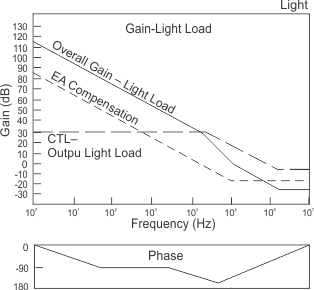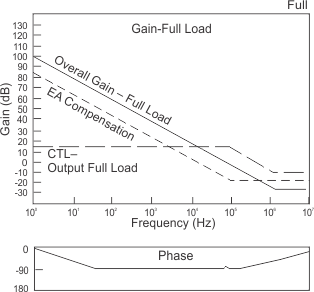SLUS873C January 2009 – December 2016 UC1825A-SP
PRODUCTION DATA.
- 1 Features
- 2 Applications
- 3 Description
- 4 Revision History
- 5 Description (continued)
- 6 Pin Configuration and Functions
- 7 Specifications
- 8 Detailed Description
-
9 Application and Implementation
- 9.1 Application Information
- 9.2
Typical Application
- 9.2.1 Design Requirements
- 9.2.2
Detailed Design Procedure
- 9.2.2.1 Auxiliary Supply Voltage
- 9.2.2.2 Oscillator Frequency
- 9.2.2.3 Preliminary Considerations
- 9.2.2.4 Input Power
- 9.2.2.5 Primary Current
- 9.2.2.6 Sense Resistor R(s)
- 9.2.2.7 MOSFET DC Losses
- 9.2.2.8 Selection of Core Material
- 9.2.2.9 Main Transformer Design
- 9.2.2.10 Calculation of Transformer
- 9.2.2.11 Minimum Core Size
- 9.2.2.12 Core Loss Limited Conditions
- 9.2.2.13 Core Geometry Selection
- 9.2.2.14 Wire Size Selection
- 9.2.2.15 Calculate Secondary RMS Current
- 9.2.2.16 Transformer Assembly
- 9.2.2.17 Calculation of Winding Resistances and Losses
- 9.2.2.18 Transformer Power Losses
- 9.2.2.19 Output Section
- 9.2.2.20 UC1825A-SP PWM Control Section
- 9.2.2.21 Closing the Feedback Loop
- 9.2.2.22 Summary
- 9.2.3 Application Curves
- 10Power Supply Recommendations
- 11Layout
- 12Device and Documentation Support
- 13Mechanical, Packaging, and Orderable Information
Package Options
Mechanical Data (Package|Pins)
Thermal pad, mechanical data (Package|Pins)
Orderable Information
7 Specifications
7.1 Absolute Maximum Ratings
over operating free-air temperature range (unless otherwise noted)(1)
(1) Stresses beyond those listed under Absolute Maximum Ratings may cause permanent damage to the device. These are stress ratings only, which do not imply functional operation of the device at these or any other conditions beyond those indicated under Recommended Operating Conditions. Exposure to absolute-maximum-rated conditions for extended periods may affect device reliability.
7.2 ESD Ratings
| VALUE | UNIT | |||
|---|---|---|---|---|
| V(ESD) | Electrostatic discharge | Human-body model (HBM), per ANSI/ESDA/JEDEC JS-001(1) | ±4000 | V |
(1) JEDEC document JEP155 states that 500-V HBM allows safe manufacturing with a standard ESD control process.
7.3 Recommended Operating Conditions
over operating free-air temperature range (TA = TJ = –55°C to 125°C), unless otherwise noted| MIN | MAX | UNIT | ||
|---|---|---|---|---|
| VCC | Supply voltage | 12 | 20 | V |
| Sink/source output current (continuous or time average) | 0 | 100 | mA | |
| Reference load current | 0 | 10 | mA | |
7.4 Thermal Information
| THERMAL METRIC(1) | UC1825A-SP | UNIT | |
|---|---|---|---|
| J (CDIP) | |||
| 16 PINS | |||
| RθJA | Junction-to-ambient thermal resistance | 55.6 | °C/W |
| RθJC(top) | Junction-to-case (top) thermal resistance | N/A | °C/W |
| RθJB | Junction-to-board thermal resistance | 33.3 | °C/W |
| ψJT | Junction-to-top characterization parameter | 10.3 | °C/W |
| ψJB | Junction-to-board characterization parameter | 35.89 | °C/W |
| RθJC(bot) | Junction-to-case (bottom) thermal resistance | 8.024 | °C/W |
(1) For more information about traditional and new thermal metrics, see the Semiconductor and IC Package Thermal Metrics application report, SPRA953.
7.5 Electrical Characteristics
TA = –55°C to 125°C, RT = 3.65 kΩ, CT = 1 nF, VCC = 12 V, TA = TJ (unless otherwise noted)| PARAMETER | TEST CONDITIONS | MIN | TYP | MAX | UNIT | |
|---|---|---|---|---|---|---|
| REFERENCE, VREF | ||||||
| VO | Ouput voltage | TJ = 25°C, IO = 1 mA | 5.05 | 5.1 | 5.15 | V |
| Line regulation | 12 V ≤ VCC ≤ 20 V | 2 | 15 | mV | ||
| Load regulation | 1 mA ≤ IO ≤ 10 mA | 5 | 20 | mV | ||
| Total output variation | Line, load, temperature | 5.03 | 5.17 | V | ||
| Temperature stability(1) | T(min) < TA < T(max) | 0.2 | 0.4 | mV/°C | ||
| Output noise voltage | 10 Hz < f < 10 kHz | 50 | μVRMS | |||
| Short circuit current | VREF = 0 V | 30 | 60 | 90 | mA | |
| OSCILLATOR | ||||||
| fOSC | Initial accuracy(1) | TJ = 25°C | 375 | 400 | 425 | kHz |
| RT = 6.6 kΩ, CT = 220 pF, TA = 25°C | 0.9 | 1 | 1.1 | MHz | ||
| Total variation(1) | Line, temperature | 350 | 450 | kHz | ||
| RT = 6.6 kΩ, CT = 220 pF | 0.82 | 1.18 | MHz | |||
| Voltage stability | 12 V < VCC < 20 V | 1% | ||||
| Temperature stability | T(min) < TA < T(max) | ±5% | ||||
| High-level output voltage, clock | 3.7 | 4 | V | |||
| Low-level output voltage, clock | 0 | 0.2 | V | |||
| Ramp peak | 2.6 | 2.8 | 3 | V | ||
| Ramp valley | 0.7 | 1 | 1.25 | V | ||
| Ramp valley-to-peak | 1.55 | 1.8 | 2 | V | ||
| IOSC | Oscillator discharge current | RT = OPEN, VCT = 2 V | 8.5 | 10 | 11 | mA |
| ERROR AMPLIFIER | ||||||
| Input offset voltage | 2 | 10 | mV | |||
| Input bias current | 0.6 | 3 | μA | |||
| Input offset current | 0.1 | 1 | μA | |||
| Open loop gain | 1 V < VO < 4 V | 60 | 95 | dB | ||
| CMRR | Common mode rejection ratio | 1.5 V < VCM < 5.5 V | 75 | 95 | dB | |
| PSRR | Power supply rejection ratio | 12 V < VCC < 20 V | 85 | 110 | dB | |
| IO(sink) | Output sink current | VEAOUT = 1 V | 1 | 2.5 | mA | |
| IO(src) | Output source current | VEAOUT = 4 V | –0.5 | –1.3 | mA | |
| High-level output voltage | IEAOUT = –0.5 mA | 4.5 | 4.7 | 5 | V | |
| Low-level output voltage | IEAOUT = –1 mA | 0 | 0.5 | 1 | V | |
| Gain bandwidth product(1) | f = 200 kHz | 6 | 12 | MHz | ||
| Slew rate(1) | 5 | 7 | V/μs | |||
| PWM COMPARATOR | ||||||
| IBIAS | Bias current, RAMP | VRAMP = 0 V | –1 | –8 | μA | |
| Minimum duty cycle | 0% | |||||
| Maximum duty cycle | 85% | |||||
| tLEB | Leading edge blanking time | RLEB = 2 kΩ, CLEB = 470 pF | 300 | 375 | 450 | ns |
| RLEB | Leading edge blanking resistance | VCLK/LEB = 3 V | 8.5 | 10 | 11.5 | kΩ |
| VZDC | Zero DC threshold voltage, EAOUT | VRAMP = 0 V | 1.10 | 1.25 | 1.4 | V |
| tDELAY | Delay-to-output time(1) | VEAOUT = 5-V to 0-V step | 50 | 120 | ns | |
| CURRENT LIMIT, START SEQUENCE, FAULT | ||||||
| ISS | Soft-start charge current | VSS = 2.5 V | 8 | 14 | 20 | μA |
| VSS | Full soft-start threshold voltage | 4.3 | 5 | V | ||
| IDSCH | Restart discharge current | VSS = 2.5 V | 100 | 250 | 350 | μA |
| ISS | Restart threshold voltage | 0 V ≤ VILIM ≤ 1.5 V | 0.3 | 0.5 | V | |
| IBIAS | ILIM bias current | 15 | μA | |||
| ICL | Current limit threshold voltage | 0.95 | 1 | 1.05 | V | |
| Overcurrent threshold voltage | 1.14 | 1.2 | 1.26 | V | ||
| td | Delay-to-output time, ILIM(1) | VILIM = 0-V to 2-V step | 50 | 80 | ns | |
| OUTPUT | ||||||
| Low-level output saturation voltage | IOUT = 20 mA | 0.25 | 0.45 | V | ||
| IOUT = 200 mA | 1.2 | 2.2 | ||||
| High-level output saturation voltage | IOUT = –20 mA | 1.9 | 2.9 | V | ||
| IOUT = –200 mA | 2 | 3 | ||||
| tr, tf | Rise/fall time(1) | CL = 1 nF | 20 | 45 | ns | |
| UNDERVOLTAGE LOCKOUT (UVLO) | ||||||
| Start threshold voltage | 8.3 | 9.2 | 9.6 | V | ||
| UVLO hysteresis | 0.4 | 0.8 | 1.25 | V | ||
| SUPPLY CURRENT | ||||||
| Isu | Start-up current | VC = VCC = 8 V | 100 | 300 | μA | |
| ICC | Input current | 28 | 36 | mA | ||
(1) Parameters ensured by design and/or characterization, if not production tested.
7.6 Typical Characteristics

